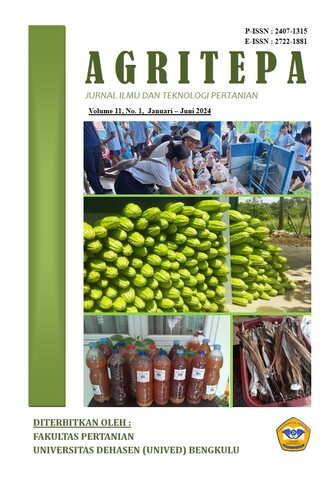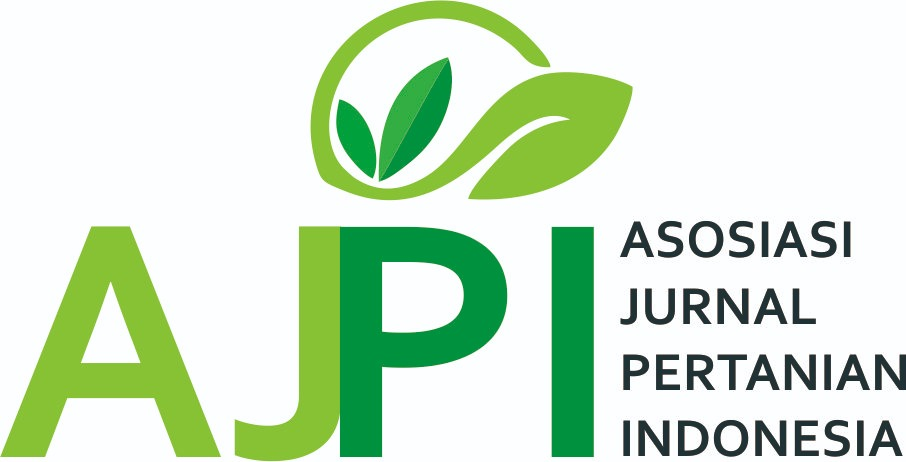Study of Pineapple Juice Addition Towards Physicochemical Characteristics and Consumer Acceptability of Soyghurt
Abstract
Purpose: This study aims to analyze the effect of adding pineapple juice at different concentrations on the viscosity, total solids, total dissolved solids, color, and consumer acceptance of soygurt. Methodology: A Completely Randomized Design (CRD) was used in this study, with the independent variable being the variation in the concentration of added pineapple juice (0%, 5%, 10%, 15%). Results: The results show that viscosity, total solids, total dissolved solids, and color are significantly influenced by the addition of pineapple juice. Findings: The consumer acceptance test indicated that the treatment with 10% pineapple juice had the best organoleptic value and was well accepted by consumers, with an average score of 4.11. Novelty: This research explores the enhancement of soygurt by adding pineapple juice, a novel approach to improving its taste and consumer appeal. Originality: The study provides a detailed analysis of the physicochemical and sensory characteristics of soygurt enhanced with pineapple juice. Conclusions: Adding pineapple juice to soygurt significantly improves its viscosity, total solids, total dissolved solids, and color, with 10% being the most favorable concentration for consumer acceptance. Type of Paper: Empirical Research Article
Downloads
References
Adawiyah, D. (2013). Pengukuran Warna Produk Pangan. Food Review Indonesia.
Azizah, N., Pramono, Y. B., & Abduh, S. B. (2013). Sifat Fisik, Organoleptik, Dan Kesukaan Yogurt Drink Dengan Penambahan Ekstrak Buah Nangka. Jurnal Aplikasi Teknologi Pangan, 2(3), 148–151.
Badan Pusat Statistik. (2021). Produksi Tanaman Buah-buahan 2021. Badan Pusat Statistik. https://www.bps.go.id/indicator/55/62/1/produksi-tanaman-buah-buahan.html
Bahanawan, A., & Sugiyanto, K. (2020). Pengaruh Pengeringan Terhadap Perubahan Warna, Penyusutan Tebal, Dan Pengurangan Berat Empat Jenis Bambu. Jurnal Penelitian Hasil Hutan, 38(2), 69–80. https://doi.org/10.20886/jphh.2020.38.2.69-80
Chauliyah, A. I. N., & Murbawani, E. A. (2015). Analisis Kandungan Gizi Dan Aktivitas Antioksidan Es Krim Nanas Madu. Journal of Nutrition College, 4(2), 628–635.
Diasari, N. R., Nurrahman, & Yusu, M. (2021). Aktivitas antioksidan dan sifat fisik soyghurt edamame dengan penambahan bit merah. Jurnal Penelitian Ilmu-Ilmu Teknologi Pangan, 10(1), 1–12.
Endrasari, R., & Nugraheni, D. (2012). Pengaruh Berbagai Cara Pengolahan Sari Kedelai Terhadap Penerimaan Organoleptik. November, 468–475.
Evadewi, F. D., & Tjahjani, C. M. P. (2021). Viskositas, Keasaman, Warna, dan Sifat Organoleptik Yogurt Susu Kambing yang Diperkaya dengan Ekstrak Beras Hitam. Jurnal Ilmiah Universitas Batanghari Jambi, 21(2), 837. https://doi.org/10.33087/jiubj.v21i2.1565
Fidyasari, A., Firdauzy, S., & Maslukah, W. (2022). Physical And Organoleptic Quality Of Tempe Synbiotic Ice Cream With Comparision Of The Mount Of Pineapple Fermentation Result (Ananas comosus (L) Merr). Jurnal Inovasi Penelitian, 3(3), 5595–5602.
Hendarto, D., Handayani, A., Esterelita, E., & Handoko, Y. (2021). Mekanisme Biokimiawi dan Optimalisasi Lactobacillus bulgaricus dan Streptococcus thermophilus dalam Pengolahan Yoghurt yang Berkualitas. Jurnal Sains Dasar, 8(1), 13–19. https://doi.org/10.21831/jsd.v8i1.24261
Ismawati, N. (2016). Nilai Ph, Total Padatan Terlarut, Dan Sifat Sensoris Yoghurt Dengan Penambahan Ekstrak Bit (Beta vulgaris L.). Jurnal Aplikasi Teknologi Pangan, 5(3), 89–93. https://doi.org/10.17728/jatp.181
Istiqomah. (2014). Karakteristik Mutu Susu Kedelai Baluran. Universitas Jember.
Jayalalitha, V., Manoharan, A., Balasundaram, B., & Elango, A. (2015). Formulation of Value Enriched Yoghurt with Soy Milk and Mango Pulp. Journal of Nutrition & Food Sciences, 05(06). https://doi.org/10.4172/2155-9600.1000427
Kabuli, K. K., Indriani, Y., & Situmorang, S. (2018). Analisis Pengetahuan dan Sikap Konsumen dalam Membeli Yoghurt di Bandar Lampung. Jiia, 6(2), 196–204.
Krisnaningsih, A. T. N., Rosyidi, D., Radiati, L. E., & Purwadi, P. (2018). Pengaruh Penambahan Stabilizer Pati Talas Lokal (Colocasia esculenta) terhadap Viskositas, Sineresis dan Keasaman Yogurt pada Inkubasi Suhu Ruang. Jurnal Ilmu Dan Teknologi Peternakan Tropis, 5(2), 5. https://doi.org/10.33772/jitro.v5i3.4706
Kusmawati, S., Rizqiati, H., Nurwantoro, & Susanti, S. (2020). Analisis Kadar Alkohol, Nilai pH, Viskositas dan Total Khamir pada Water Kefir Semangka dengan Variasi Konsentrasi Sukrosa. Jurnal Teknologi Pangan, 4(2), 127–130.
Kusumawati, I., Purwanti, R., & Afifah, D. N. (2019). Analisis Kandungan Gizi Dan Aktivitas Antioksidan Pada Yoghurt Dengan Penambahan Nanas Madu (Ananas comosus Mer.) Dan Ekstrak Kayu Manis (Cinnamomum burmanni). Journal of Nutrition College, 8(4), 196–206. https://doi.org/10.14710
Lumbantoruan, P., & Yulianti, E. (2016). Pengaruh Suhu terhadap Viskositas Minyak Pelumas (Oli). Jurnal Sainmatika, 13(2), 26–34.
Maleta, H. S., Indrawati, R., Limantara, L., & Brotosudarmo, T. H. P. (2018). Ragam Metode Ekstraksi Karotenoid dari Sumber Tumbuhan dalam Dekade Terakhir (Telaah Literatur). Jurnal Rekayasa Kimia & Lingkungan, 13(1), 40–50. https://doi.org/10.23955/rkl.v13i1.10008
Margareta, M. dan M. (2021). Pengaruh Lama Perendaman Biji Kedelai (Glycine max L. Merr) terhadap Karakteristik Organoleptik Susu Kedelai. Journal of Agriculture and Human Resource Development Studies, 2(1), 9–14.
Maris, I., & Radiansyah, M. R. (2021). Review of Plant-Based Milk Utilization As a Substitute for Animal Milk. Food Scientia : Journal of Food Science and Technology, 1(2), 103–116. https://doi.org/10.33830/fsj.v1i2.2064.2021
Marwati, Prasetyo, R., & Yuliani. (2021). Respons Sensoris Dan Waktu Leleh Es Krim Nabati Berbahan Sari Kedelai Dan Pisang Mauli (Musa sp). Journal of Tropical AgriFood, 3(1), 15–22.
Moyouwou, A. N., Waingeh, N., Yunenui, M., & Imele, H. (2016). Physicochemical, Microbiological and Sensory Properties of Pineapple (Ananas comosus (L.) Flavored Yoghurt. International Journal of Agriculture Innovations and Research, 4(6), 1154–1158. https://doi.org/10.1093/nq/cxlviii.jun27.463d
Nofrianti, R., Azima, F., & Eliyasmi, R. (2013). Pengaruh Penambahan Madu Terhadap Mutu Yoghurt Jagung. Jurnal Apl, 2(2).
Novita, R., Sadjadi, S., Karyono, T., & Mulyono, R. (2019). Level Ekstrak Buah Nanas (Ananas comosus L. Merr) dan Lama Perendaman Terhadap Kualitas Daging Itik Afkir. Jurnal Peternakan Indonesia (Indonesian Journal of Animal Science), 21(2), 143. https://doi.org/10.25077/jpi.21.2.143-153.2019
Nugraheni, M. (2020). Pewarna Alami Makanan Dan Potensi Fungsionalnya (Vol. 21, Issue 1). Univesitas Negeri Yogyakarta.
Nuraeni, Y., Wijana, S., & Susilo, B. (2019). Analisa Komparatif Sifat Fisikokimia Sari Buah dan Konsentrat Sari Buah Antara Hasil Olahan Nanas (Ananas comosus (L) Merr.) Varietas Queen Grade C dan Grade B. Jurnal Pertanian Terpadu, 7(1), 16–27. https://doi.org/10.36084/jpt..v7i1.166
Purnamayanti, Ni. P. A., Ida, B. P., & Gede, A. (2017). Pengaruh Suhu dan Lama Penyangraian Terhadap Karakteristik Fisik dan Mutu Sensori Kopi Arabika (Coffea arabica L). Jurnal BETA (Biosistem Dan Teknik Pertanian, 5(2), 39–48.
Ramadhani, D., & Sumanjaya, R. (2014). Analisis Faktor-faktor Yang Mempengaruhi Ketersediaan Kedelai Di Indonesia. Jurnal Ekonomi Dan Keuangan, 2(3).
Ratnasari, U. (2022). Pengaruh penambahan jenis gula berbeda terhadap karakteristik fisikokimia dan organoleptik yoghurt nanas. Politeknik Negeri Subang.
Rizal, S., Erna, M., Nurainy, F., & Tambunan, A. R. (2016). Karakteristik Probiotik Minuman Fermentasi Laktat Sari Buah Nanas dengan Variasi Jenis Bakteri Asam Laktat. Jurnal Kimia Terapan Indonesia, 18(01), 63–71. https://doi.org/10.14203/jkti.v18i01.41
Rohman, E., & Maharani, S. (2020). Peranan Warna, Viskositas, Dan Sineresis Terhadap Produk Yoghurt. Edufortech, 5(2). https://doi.org/10.17509
Sawant, P., Kumar, D., Patil, V., Ingale, Y., & Sawant, D. (2015). Physico-chemical, Sensory and Microbial Quality of Yoghurt Drink Fortified with Pineapple Pulp. International Journal of Food and Fermentation Technology, 5(1), 69. https://doi.org/10.5958/2277-9396.2015.00008.2
Sinaga, A. S. (2019). Segmentasi Ruang Warna L*a*b. Jurnal Mantik Penusa, 3(1), 43–46.
Singh-Ackbarali, D., & Maharaj, R. (2014). Sensory Evaluation as a Tool in Determining Acceptability of Innovative Products Developed by Undergraduate Students in Food Science and Technology at The University of Trinidad and Tobago. Journal of Curriculum and Teaching, 3(1). https://doi.org/10.5430/jct.v3n1p10
Sintasari, R. A., Kusnadi, J., & Ningtyas, D. W. (2014). Pengaruh Penambahan Konsentrasi Susu Skim Dan Sukrosa Terhadap Karakterisik Minuman Probiotik Sari Beras Merah. Jurnal Pangan Dan Agroindustri, 2(3), 65–75.
Standar Nasional Indonesia. (2004). SNI 01-3542-2004 Kopi Bubuk.
Standar Nasional Indonesia. (2009). SNI 2981:2009 Yoghurt.
Sulasih, Legowo, A., Iskandar, B., & Tampoebolon, M. (2018). Aktivitas Antioksidan, BAL, Viskositas dan Nilai L * a * b * dalam Yogurt yang Diperkaya dengan Probiotik Bifidobacterium longum dan Buah Naga Merah (Hylocereus polyrhizus). Jurnal Aplikasi Teknologi Pangan, 7(4), 151–156.
Ulfiana, E., & M. Has, E. M. (2019). Pemberdayaan Kaum Ibu Melalui Pengolahan Susu Kedelai Sebagai Upaya Peningkatan Gizi Keluarga. Jurnal Pengabdian Masyarakat Dalam Kesehatan, 1(1), 21. https://doi.org/10.20473/jpmk.v1i1.12327
Wardani, E. K., Zulaekah, S., & Purwani, E. (2017). Pengaruh Penambahan Sari Buah Nanas (Ananas comosus) terhadap Jumlah Bakteri Asam Laktat (BAL) dan Nilai pH Soyghurt. Jurnal Kesehatan, 10(1), 68. https://doi.org/10.23917/jurkes.v10i1.5494
Widagdha, S., & Choirun Nisa, F. (2015). Karakteristik Fisiko Kimia Yoghurt Sari Anggur-Widagdha, dkk. In Jurnal Pangan dan Agroindustri (Vol. 3).
Wiratmawati, A. (2014). Kadar Protein Dan Organoleptik Yoghurt Susu Kedelai (Soyghurt) Dengan Penambahan Gula Dan Sari Buah Nanas (Ananas comosus). Universitas Muhammadiyah Surakarta.
Copyright (c) 2024 Nur Phi Lintang Kamulyan Sulityo, Masayu Nur Ulfa, Syahrizal Nasution (Author)

This work is licensed under a Creative Commons Attribution-ShareAlike 4.0 International License.
Author retains the copyright and grants the journal the right of first publication of the work simultaneously licensed under the Creative Commons Attribution-ShareAlike 4.0 License that allows others to share the work with an acknowledgement of the work's authorship and initial publication in this journal













